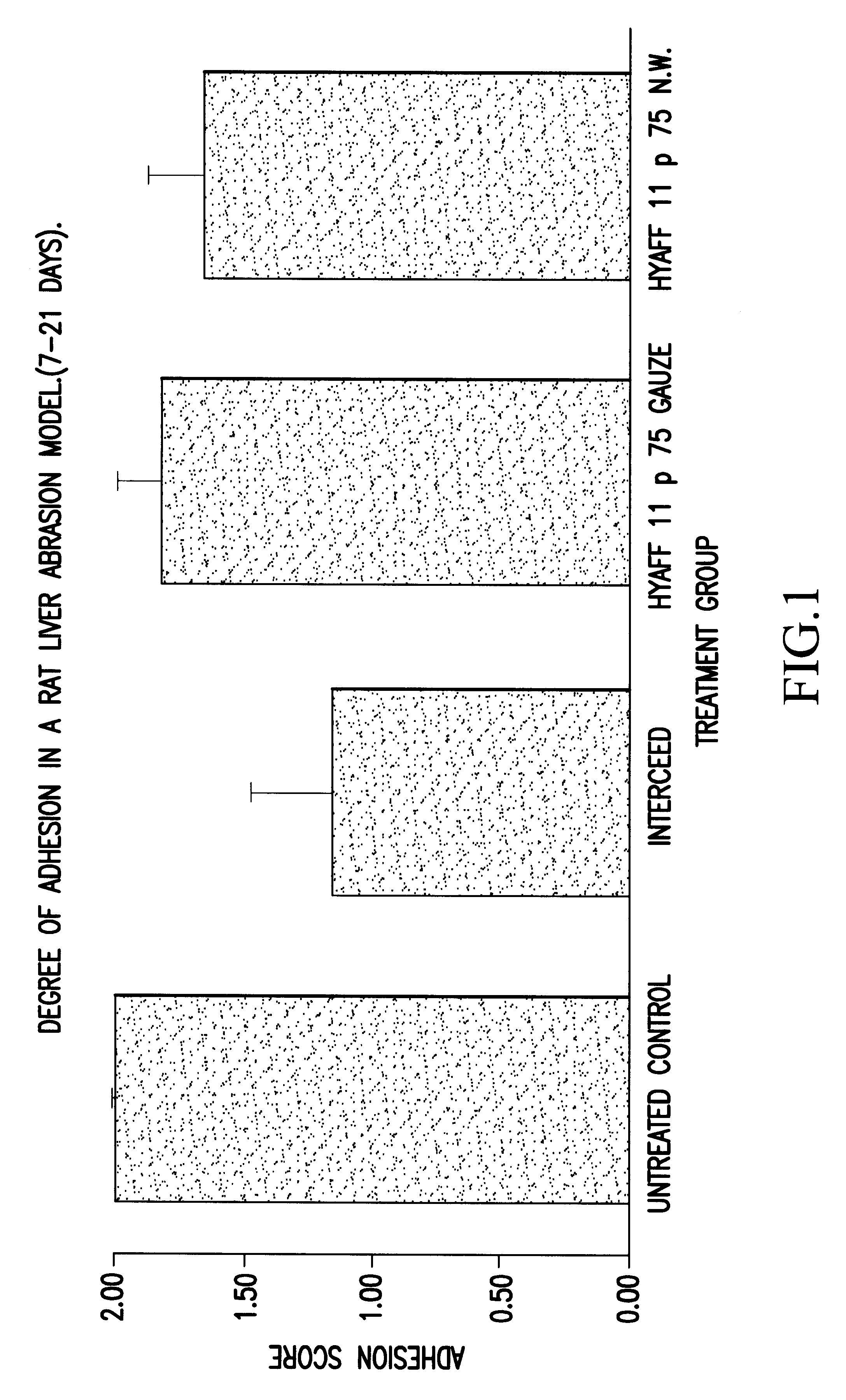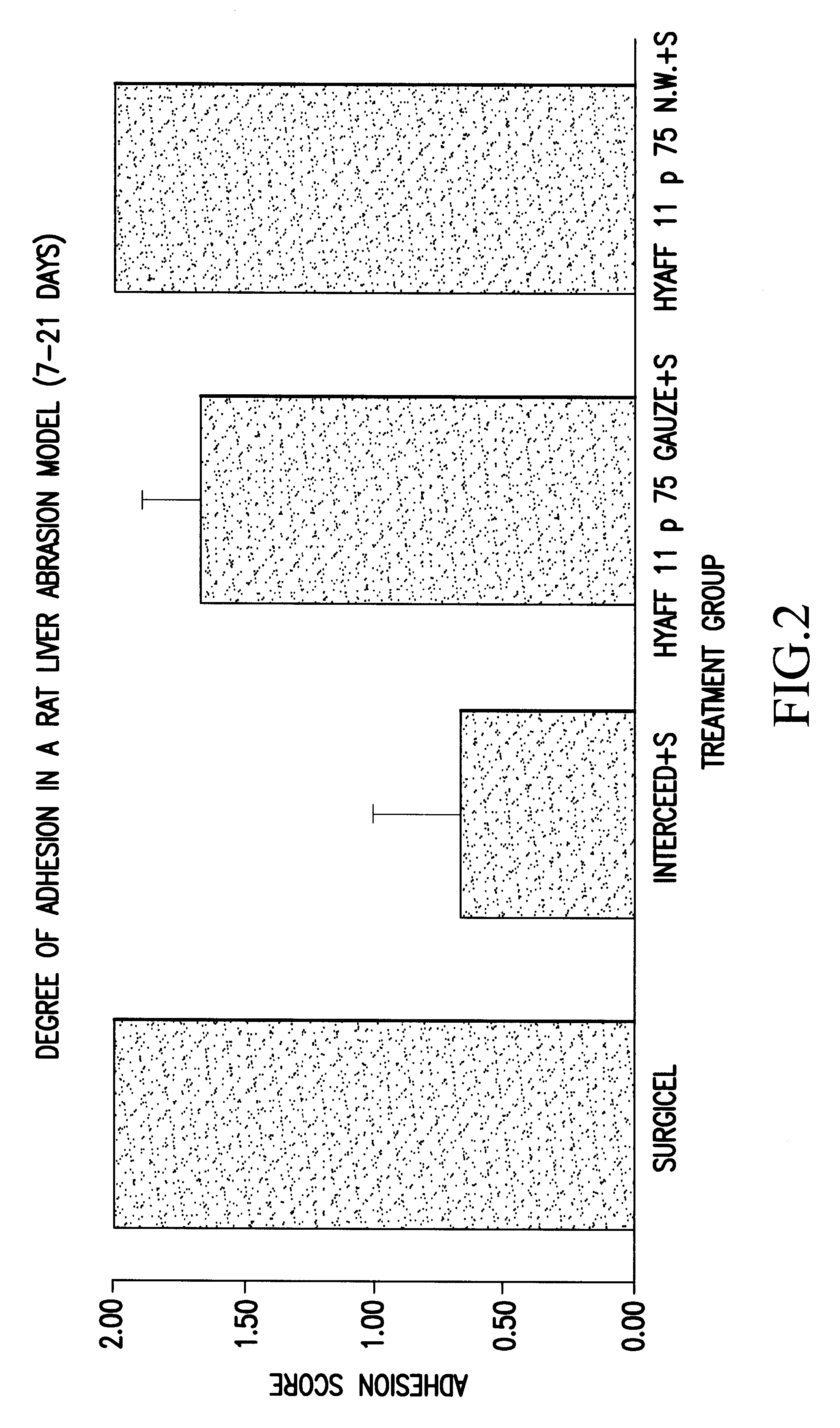Biomaterials for preventing post-surgical adhesions comprised of hyaluronic acid derivatives
a technology of biomaterials and hyaluronic acid, applied in the field of new biomaterials, can solve problems such as substantial morbidity
- Summary
- Abstract
- Description
- Claims
- Application Information
AI Technical Summary
Benefits of technology
Problems solved by technology
Method used
Image
Examples
example 2
Preparation of the 100% Benzyl Ester of Hyaluronic Acid (HYAFF 11)
3 g of the potassium salt of HA with a molecular weight of 162,000 are suspended in 200 ml of dimethylsulfoxide; 120 mg of tetrabutylammonium iodide and 2.4 g of benzyl bromide are added.
The suspension is kept in agitation for 48 hours at 30.degree. C. The resulting mixture is slowly poured into 1,000 ml of ethyl acetate under constant agitation. A precipitate is formed which is filtered and washed four times with 150 ml of ethyl acetate and finally vacuum dried for twenty four hours at 30.degree..
3.1 g of the benzyl ester product in the title are obtained. Quantitative determination of the ester groups is carried out according to the method described on pages 1698-172 of Siggia S. and Hanna J. G. "Quantitative organic analysis via functional groups" 4th Edition, John Wiley and Sons.
example 3
Preparation of a Hyaluronic Acid Derivative With 75% of its Carboxyl Functions Esterified With Benzyl Alcohol and the Remaining 25% Esterified With Octadecyl Alcohol (Stearyl Alcohol, CH.sub.3 --(CH.sub.2).sub.16 --CH.sub.2 --OH)
6.21 g of tetrabutyl ammonium salt of hyaluronic acid with a molecular weight of 180,000 Daltons (10 mEq) are solubilized in 248 ml of dimethylsulfoxide (DMSO) at room temperature.
This solution is supplemented with 0.89 ml of benzyl bromide (7.5 mEq) and the solution is left to stand at 30.degree. C for 12 hours. The solution is then cooled to room temperature and supplemented with 0.83 g of octadecyl bromide (2.5 mEq). The solution is heated to 30.degree. C. for 24 hours. A 2.5% solution (w / w) of NaCl in water is then added and the resulting mixture is poured into 750 ml of acetone, stirring the while. A precipitate is formed which is filtered and washed three times in 100 ml of acetone / water 5:1, three times with 100 ml of acetone and then dried in a high ...
example 4
Preparation of a Hyaluronic Acid Derivative With 75% of its Carboxyl Functions Esterified With Benzyl Alcohol and the Remaining 25% Esterified With Hexadecyl Alcohol (Cetyl Palmityl Alcohol, CH.sub.3 --(CH.sub.2).sub.14 --CH.sub.2 --OH)
6.21 g of tetrabutyl ammonium salt of hyaluronic acid with a molecular weight of 180,000 Daltons (10 mEq) are solubilized in 248 ml of dimethylsulfoxide (DMSO) at room temperature.
This solution is supplemented with 0.89 ml of benzyl bromide (7.5 mEq) and the solution is left to stand at 30.degree. C. for 12 hours. The solution is then cooled to room temperature and supplemented with 0.76 g of hexadecyl bromide (2.5 mEq). The solution is heated to 30.degree. C. for 24 hours. A 2.5% solution (w / w) of NaCl in water is then added and the resulting mixture is poured into 750 ml of acetone, stirring the while. A precipitate is formed which is filtered and washed three times in 100 ml of acetone / water 5:1, three times with 100 ml of acetone and then dried in...
PUM
| Property | Measurement | Unit |
|---|---|---|
| Fraction | aaaaa | aaaaa |
| Fraction | aaaaa | aaaaa |
| Fraction | aaaaa | aaaaa |
Abstract
Description
Claims
Application Information
 Login to View More
Login to View More - R&D
- Intellectual Property
- Life Sciences
- Materials
- Tech Scout
- Unparalleled Data Quality
- Higher Quality Content
- 60% Fewer Hallucinations
Browse by: Latest US Patents, China's latest patents, Technical Efficacy Thesaurus, Application Domain, Technology Topic, Popular Technical Reports.
© 2025 PatSnap. All rights reserved.Legal|Privacy policy|Modern Slavery Act Transparency Statement|Sitemap|About US| Contact US: help@patsnap.com



